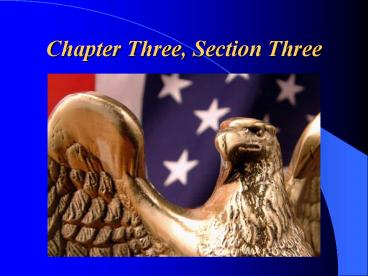Chapter Three, Section Three PowerPoint PPT Presentation
1 / 30
Title: Chapter Three, Section Three
1
Chapter Three, Section Three
2
The Structure of the Constitution
3
Supreme Law of the Land
4
Supreme Law of the Land
- The new U.S. Constitution is the highest
authority in the nation. - All power of the U.S. Government is derived from
this document.
5
Parts of the Constitution
6
The Preamble
7
Preamble
- We the People of the United States, in Order to
form a more perfect Union, establish Justice,
insure domestic Tranquility, provide for the
common defense, promote the general Welfare, and
secure the Blessings of Liberty to ourselves and
our Posterity, do ordain and establish this
Constitution for the United States of America.
8
To Form a more perfect Union
- To unite the states more effectively so they can
operate as a single nation, for the good of all
9
To establish Justice
- To create a system of fair laws and courts and
make certain that all citizens are treated
equally.
10
To insure domestic Tranquility
- To maintain peace and order, keeping citizens and
property safe from harm.
11
To provide for the common defense
- To be ready militarily to protect the country and
its citizens from outside attack.
12
To promote the general Welfare
- To help people live healthy, happy, and
prosperous lives
13
To secure the Blessings of Liberty to ourselves
and our Posterity
- To guarantee the freedom and basic rights of all
Americans, including future generations
(posterity).
14
The Articles
15
Article I
- Article I establishes the Legislative Branch
(U.S. Congress). - It creates the Senate and the House of
Representatives. - Congress has the task of making laws.
- Only Congress can declare war or coin money.
16
Article II
- Article II establishes the Executive Branch (U.S.
President Vice President). - It establishes procedures for electing the
president and vice president - President has the task of carrying out laws.
17
Article III
- Article III establishes the Judicial Branch (U.S.
Supreme Court with 9 justices). - It establishes the powers of the Court and the
cases they will hear. - Supreme Court has the task of interpreting our
laws.
18
Article IV
- Article IV establishes the relations of the
states and the rights of citizens. - It establishes good will among states.
- Promises U.S. protection of the states.
19
Article V
- Article V discusses the amendments of the
Constitution (currently 27) - Amending (or changing) allows the Constitution
to change with the times. - Bill of Rights are the first 10 amendments
20
Article VI
- Article VI discusses the supremacy of the
Constitution. - The Constitution is the highest authority in the
land. - If state law contradicts the Constitution, the
Constitution wins.
21
Article VII
- Article VII discusses the ratification (or
approval) of the Constitution. - It requires 9 out of 13 states to ratify before
the Constitution can go into effect.
22
Amending the Constitution
23
Amending the Constitution
- 1791, the first amendments were added to the
Constitution. - These are the Bill of Rights.
- Thousands have been suggested, but only 27 have
been made!
24
Amending the Constitution
- All amendments must begin by being proposed
- To propose an amendment, it requires either a (1)
vote of 2/3 of both houses of Congress OR (2)
national convention called for by 2/3 of state
legislatures. - Most amendments begin with (1)
25
Amending the Constitution
- All amendments must end by being ratified
- To ratify an amendment, it requires either a (1)
¾ of state legislatures approval OR (2) ¾ of
state Ratifying Conventions. - Only Amendment 21 ratified by (2)
26
Interpreting the Constitution
- The Necessary and Proper Clause states Congress
has the power to make all Laws which shall be
necessary and proper - Article I, Section 8, Clause 8
27
Interpreting the Constitution
- Known as the Elastic Clause, this gives
Congress flexibility to make what laws it seems
are necessary and proper. - This is an implied power and not specifically
mentioned.
28
Interpreting the Constitution
- Supreme Court decisions also have a major impact.
- They have final authority on interpreting the
Constitution. - These have differed over time depending on the
make up of the Court.
29
Interpreting the Constitution
- Congress and the presidents have also interpreted
the Constitution - Cases of impeachment and presidential succession.
30
Interpreting the Constitution
- Although not in the Constitution, the creation of
political parties has also changed the way we
look at this document.

